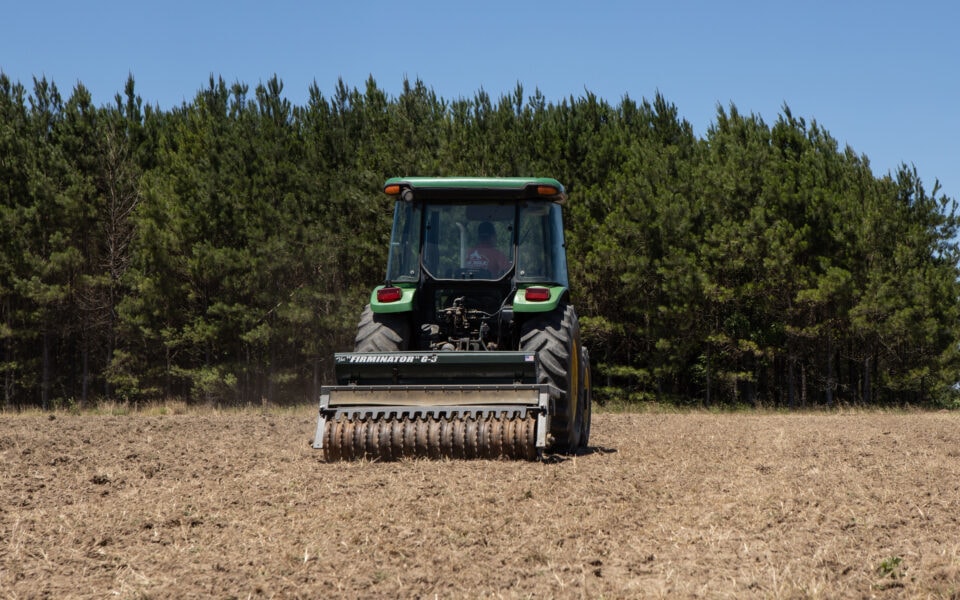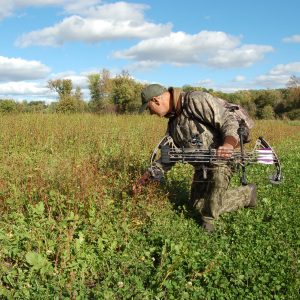Now that we’ve spent countless labor-filled days clearing land, planting food plots and maintaining them, winter is closing in and every gamekeeper should be winterizing their equipment and implements for the idle winter months. Neglect during the winter months can lead to costly repairs and delays when springtime finally does arrive. The upfront costs of proper winterization are much smaller than the costs of repair or replacement.
Taking care of your implements and equipment is multidimensional and requires some planning and careful attention. Don’t be fooled by thinking that you shouldn’t need to winterize unless you live in a cold region. Any time that you put away your equipment for a long period of time during the winter months you should take steps to prepare it. However, especially if you live in a region that experiences a lot of cold weather, check your tractors for proper amounts and mixtures of antifreeze to prevent the cracking of the engine block or radiator. This simple check can save you thousands of dollars.

Jarrod Stephens
Winterizing Your Equipment Fuel Systems
If you have never considered fuel stabilization in all your fuel engines, now is the time. Both diesel and gasoline engines that are not being used during the winter months should be prepped for winter storage. Fuel stabilization and winterizing techniques for both small and large engines are both necessary and inexpensive.
If you store fuel in containers or tanks, put fuel stabilizer in them. It can protect the fuel and keep it fresh for future use. You should also put fuel stabilizer in fuel tanks of all engines even if you plan to use them during the winter. Fuel stabilizer is simply poured into the fuel and can be purchased at any auto parts store. In larger equipment such as tractors and mowers you can keep fuel systems in working order by periodically starting the engines and allowing them to run for a short period of time.
Fuel tanks on smaller 2-stroke engines that are common for chainsaws, weed eaters, and leaf blowers should be emptied since 2-stroke fuel contains oil. Leaving the fuel in the tank can cause it to become thick and make the carburetor sticky which leads to trouble. Empty the fuel tank, start the engine, and let it run out of fuel to burn out all oil and make it ready for storage.
Applying Grease and Oil to Your Farm Equipment
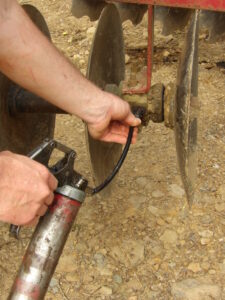
Jarrod Stephens
The farm equipment that gamekeepers use will sometimes have many moving parts. Those moving parts will require periodic lubrication throughout the season, but a final check and application for winterization purposes can prevent failure of the implements in the spring. Regular oil and filter changes, gear box oils and grease fitting lubrication should be a point of focus for your winterization efforts.
All implements with gear boxes should be checked for proper amounts of oil. The gear boxes contain fast moving parts that will heat up from friction and fail if oil levels are not maintained. Following the recommendations for gear oil types and levels in each individual piece is imperative. Typically, a gear box will have at least two plugs on the upper parts; one near the top and one that’s a little lower and will show proper oil level. Remove both plugs and begin putting oil in the top hole until it reaches the lower hole and begins to run out. Clean up any spillage immediately. Thankfully, some manufacturers have begun putting caps with dipsticks on gear boxes to make gear oil level checks easier. The oil should be removed and replaced if it appears bright yellow or is badly discolored as this could be a sign of water in the oil. Replace with the manufacturer’s recommendations.
Keeping and maintaining service records, such as oil and filter changes, is vital for the longevity of your equipment. Tractors are equipped with an hour meter that is used to monitor the number of hours between servicing. An annual service is the bare minimum for your tractor to ensure proper lubrication. Service all engines that have filters and keep an accurate record of all services rendered. Always use the recommended filters and lubricants. Don’t forget that tractors that are equipped with front end loaders and other hydraulic implements also have hydraulic filters and hydraulic oil as well.
Most all moving parts on implements have some type of lubrication point unless of course it is a sealed bearing. If the moving parts have a lubricating point it usually requires grease. Find and clean all grease fittings and replace any that are damaged. Inject a high-quality grease into each fitting until you see evidence of a filled socket. The grease will protect parts of your equipment that you will never see unless there is a failure with the part. Examine each moving part carefully and again refer to the owner’s manual of your implement to locate every lubrication point.
If you have a rotary tiller, bush hog, or any other PTO driven machinery you should oil and grease them thoroughly. Remove PTO shafts and grease both the male and female parts of the shaft. Move the parts together and apart to smear the grease on all areas. Examine the universal joints that swivel for grease fittings as well.
Cleaning Your Implements
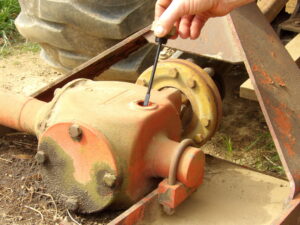
Jarrod Stephens
Any implement that has residue from the past year’s work should be thoroughly cleaned. Allowing dirt and other residue to remain on the implement will encourage oxidation and premature failure.
Bush hogs should be pressure-washed underneath and on top. Be careful to avoid spraying high pressure water on the gaskets on gear boxes to prevent injection of water or damage to the gasket. Remove any debris that is lodged around blades such as wire or strings. You’ll be surprised what your blades will find throughout the course of a season. Be sure the bush hog is secure before getting beneath it to examine the bottom. Disks, plows, planters and all implements that have soil residue should be pressure washed, too, and allowed to dry completely.
Perhaps one of the most corrosive elements that any of your equipment will come in contact with is fertilizer. Any implements such as planters and fertilize spreaders that have had exposure to corrosive fertilizers should be washed and then rubbed down with oil to add extra protection from oxidation.
Complete Minor Repairs
Disks or harrows truly take a beating while in use. The multiple disk blades cut through tough soils and encounter a lot of rocks and other debris that can bend or break the blades. Carefully inspect each disk and remove and replace any badly damaged or broken pieces. One broken blade can prevent an entire axel of disks from spinning and void your efforts to cut the soil up properly.
Plow points are the parts of the plow that initialize the cut into the soil. Dull or worn out plow points will not let your plow quickly reach and maintain the desired plowing depth which will result in uneven results. Replace worn points and then smear grease over the surface of the point and the entire moldboard to prevent wintertime oxidation.
Sharpening Blades
If you have a bush hog or mower of any type, now is the time to sharpen blades so that when spring rolls around you’ll not have any delays getting your work completed. Bush hog blades are made of a high-carbon steel which helps to make them hard and maintain an edge quite well. However, after days of cutting through trees and accidental encounters with rocks and stumps their edges can get blunt.
To sharpen mower blades, you’ll need a high-speed grinder and the bush hog will need to be properly secured, or blades removed to sharpen. This shouldn’t have to be said, but never get under a bush hog to sharpen the blades with the tractor running and without first propping the bush hog with large poles or other supports. If you discover that any blades are bent or wearing thin, it’s best to replace them instead of trying to repair. Bent blades will cause your mower to be imbalanced and the vibration can wear out bearings prematurely.
Storing Your Equipment
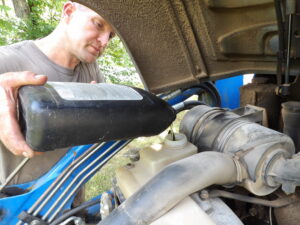
Jarrod Stephens
After all winterization has been performed you should store away all equipment. Of course, storing implements in sheds or at least under a roof is the best option. However, if you do not have underroof storage you should at least place your implements on pallets where they will not have contact with the ground and tarp them. The prevention of rust is quite important and keeping your equipment off the ground can help prevent it.
Considering the cost of equipment and food plot implements, the old adage, “An ounce of prevention is worth a pound of cure,” is certainly magnified. Don’t let neglect get in the way of your spring plans but instead take the preemptive steps and winterize your equipment today.

